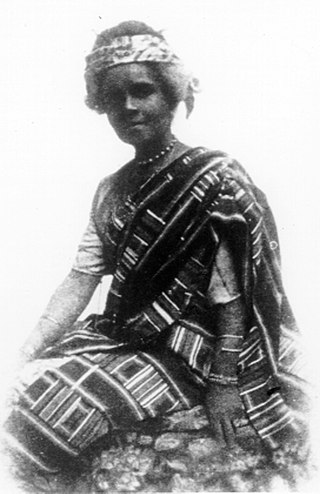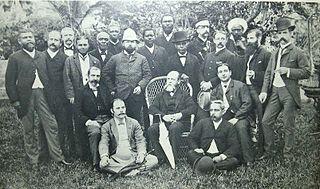Related Research Articles

Sierra Leone's music is a mixture of native, French, British, West Indian and Creole musical genres.

Adelaide Casely-Hayford, was a Sierra Leone Creole advocate, activist of cultural nationalism, teacher, fiction writer, and feminist. Committed to public service, she worked to improve the conditions of black men and women. As a pioneer of women's education in Sierra Leone, she played a key role in popularizing Pan-Africanist and feminist politics in the early 1900s. She set up a Girls' Vocational and Training School in Freetown in 1923 to instil cultural and racial pride for Sierra Leoneans under colonial rule. In pursuit of Sierra Leone national identity and cultural heritage, she caused a sensation by wearing traditional African attire in 1925 to attend a reception in honour of the Prince of Wales.
The Jamaican Maroons in Sierra Leone were a group of just under 600 Jamaican Maroons from Cudjoe's Town, the largest of the five Jamaican maroon towns who were deported by the British authorities in Jamaica following the Second Maroon War in 1796, first to Nova Scotia. Four years later in 1800, they were transported to Sierra Leone.

John Farrell Easmon, MRCS, LM, LKQCP, MD, CMO, was a prominent Sierra Leonean Creole medical doctor in the British Gold Coast who served as Chief Medical Officer during the 1890s. Easmon was the only West African to be promoted to Chief Medical Officer and he served in this role with distinction during the last decade of the 19th century. Easmon was a botanist and a noted expert on the study and treatment of tropical diseases. In 1884, he wrote a pamphlet entitled The Nature and Treatment of Blackwater Fever, which noted for the first time the relationship between blackwater fever and malaria. Easmon coined the term "blackwater fever" in his pamphlet on the malarial disease.
William Smith (1816–1895) was a Gold Coast-Sierra Leonean civil servant who worked in Freetown, Sierra Leone, as a registrar for the Mixed Commissionary Court. Due to his position and through his marriage to wealthy Freetown Creoles, Smith became a prominent figure in Sierra Leone. Smith had 14 children. Dr. Robert Smith, Francis Smith, and Adelaide Casely-Hayford are the most well known of them.

Gladys May Casely-HayfordaliasAquah Laluah was a Gold Coast-born Sierra Leonean writer. She is credited as the first author to write in the Krio language.

Robert Smith FRCSE (1840–1885) was a Sierra Leonean medical doctor who served as an Assistant Colonial Surgeon in Sierra Leone during the late nineteenth century. Smith was the first African to become a Fellow of the Royal College of Surgeons of Edinburgh after completing his medical studies at the University of Edinburgh.
Literature of Sierra Leone is the collection of written and spoken work, mostly fictional, from Sierra Leone. The coastal west-African country suffered a civil war from 1991 until 2002. Before the civil war, Sierra Leone had many writers contributing to its literature and since the end of the war the country has been in the process of rebuilding this literature. This is an overview of some important aspects of the literature of Sierra Leone before, during, and after the war.

Macormack Charles Farrell Easmon, OBE, popularly known as M. C. F. Easmon or "Charlie", was a Sierra Leone Creole born in Accra in the Gold Coast, where his father John Farrell Easmon, a prominent Creole medical doctor, was working at the time. He belonged to the notable Easmon family of Sierra Leone, a Creole family of African-American descent.

The Sierra Leone Creole people are an ethnic group of Sierra Leone. The Sierra Leone Creole people are descendants of freed African-American, Afro-Caribbean, and Liberated African slaves who settled in the Western Area of Sierra Leone between 1787 and about 1885. The colony was established by the British, supported by abolitionists, under the Sierra Leone Company as a place for freedmen. The settlers called their new settlement Freetown. Today, the Sierra Leone Creoles are 1.2 percent of the population of Sierra Leone.

The Easmon family or the Easmon Medical Dynasty is a Sierra Leone Creole medical dynasty of African-American descent originally based in Freetown, Sierra Leone. The Easmon family has ancestral roots in the United States, and in particular Savannah, Georgia and other states in the American South. There are several descendants of the Sierra Leonean family in the United Kingdom and the United States, as well as in the Ghanaian cities of Accra and Kumasi. The family produced several medical doctors beginning with John Farrell Easmon, the medical doctor who coined the term Blackwater fever and wrote the first clinical diagnosis of the disease linking it to malaria and Albert Whiggs Easmon, who was a leading gynaecologist in Freetown, Sierra Leone. Several members of the family were active in business, academia, politics, the arts including music, cultural dance, playwriting and literature, history, anthropology, cultural studies, and anti-colonial activism against racism.

Kathleen Mary Easmon Simango was a Sierra Leonean missionary and artist who was the first West African to earn a diploma from the Royal College of Art. She was the niece of Adelaide Casely-Hayford and was a personal friend of Samuel Coleridge-Taylor. Simango was also a member of the prominent Sierra Leone Creole Easmon family.
Namba Roy was a Jamaican novelist and artist. He was the father of writer and educator Lucinda Roy.
The Awoonor-Renner family or Awunor-Renner family is a Sierra Leone Creole medical, legal, and commercial dynasty with branches of the family in Ghana. The Awoonor-Renner, Awoonor-Wilson, Awoonor-Gordon families are branches of the Awoonor-Williams family that originated from Waterloo, Sierra Leone, and derived "Awoonor" from the Awuna territory in Keta. The Awoonor-Renner family has produced several distinguished doctors, lawyers, and businessmen in Sierra Leone, Ghana, and the United Kingdom. Alongside families such as the Dove family, Easmon family and Smith family, the Awoonor-Renners are among the wealthy Aristo or aristocratic Creole families. In the Gold Coast, the family was part of the country's African political elite and some members were affiliated with the Aboriginal Rights Protection Society (ARPS), which included such activists as John Mensah Sarbah, Kobina Sekyi and J. E. Casely Hayford.
The Smith family is a Sierra Leone Creole family of English, Jamaican Maroon and Liberated African descent based in Freetown, Sierra Leone. The Smiths were first-generation Sierra Leone Creoles of Gold Coast Euro-African and Caribbean origin who settled in Sierra Leone during the early 19th century. There are several descendants of the family in the United Kingdom and the United States, as well as in the Ghanaian cities of Accra and Cape Coast. Several members of the family were active in business, women's education, civil administration, the arts, medicine, poetry, the judiciary, cultural studies, Pan-Africanism and anti-colonial activism.
References
- ↑ Beshoff, Patricia (1983). "Namba Roy: Maroon Artist and Writer". Jamaica Journal. 16 (34–38). Archived from the original on 15 April 2022. Retrieved 5 February 2021.